Top>Research>Encounter with Russians under Japanese Agricultural Colonization Policy in "Manchukuo"
 Index
Index

Naho Igaue [Profile]
Education Course
Encounter with Russians under Japanese Agricultural Colonization Policy in "Manchukuo"
Naho Igaue
Associate Professor of Cultural Anthropology (Ethnology) and Russian History, Faculty of Policy Studies, Chuo University
Japanese surveys on Russian agricultural communities carried out 80 years ago
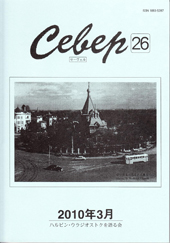
Sever (Journal)![]()
Participating as an editor of the journal Sever (Harbin-Vladivostok Discussion Society) that focuses on relations between Russians and the Japanese in the Far East.
I conduct researches on the cultural anthropology (ethnology) and history of Russia, with a particular attention on Siberia (including the Russian Far East). I am especially interested in ethnic Russians living in agricultural communities. In the former Soviet Union, it was very difficult for foreign scholars to visit villages, but now in Russia it has become allowed to stay in these places and carry out field surveys on agricultural communities. Nevertheless, it is still a rare sight for field surveys of these agricultural communities to be carried out by foreigners.
Despite this, about 80 years ago large-scale surveys were conducted by the Japanese in villages of Russians. They even shot documentary films on these villages and published related articles in general magazines like Fujin Gaho (a women's magazine). However, at that time, the villages under surveys were not a part of the Soviet Union, but were located in Northeast China. In other words, they were in the territory of Japanese puppet state "Manchukuo" that was created after the Manchurian Incident in 1931.
For last five-plus years I have been interested in modern history of Northeast China and Inner Mongolia, which border on Russia, and continued my investigations keeping contacts with researchers and informants from Japan, Russia, China, Canada, United States and Australia.
In this column, I would like to present a chapter of Japanese-Chinese-Russian relations that are being forgotten, by introducing a special encounter of Japanese people and Russian farmers who lived in Manchuria and Mongolia at that time.
Russian émigrés in Manchukuo
After the Russian Empire won the construction rights for the Chinese Eastern Railway from Qing, there was a massive influx of Russian nationals to Northeast China, mainly along the railway line. Then after, against a backdrop of the Russian Revolution in 1917 and the following Manchurian Incident in 1931, both of which were leading to a complete changeover in the power relations of the region, a great many Russian nationals left Northeast China, but at the same time many newcomers escaped from the territory of Soviet Union. As a result, from 1930s up until 1945, there were approximately 60,000 Russian émigrés (subjects of the former Russian Empire) living in the territory of Manchukuo. At that time, they were called in Japanese "white Russians", "stateless persons" and "emigrants", but hereafter they will be referred to by the term of "Russian émigrés".
In the era of Manchukuo, over half of the Russian émigrés lived in Harbin which is now the capital of Heilongjiang Province in China. Harbin was built by the Russian Empire as the center of the railroad construction and the city had a Russian flavor. Even in these days, the word "Russian émigrés" in Manchukuo makes the Japanese recall cabaret performers and singers, an atmosphere of Decadence and "Ero guro" (eroticism and grotesque), reflecting the city life of Harbin and in particular the poverty that the Russian émigrés were placed in after the Russian Revolution.
However, the Russian émigrés in Manchukuo didn't just live in the urban parts; they could also be found in rural areas as well. The life of the latter was very different to that in modern-looking Harbin, but the Japanese in those days were paying a great deal of attention to the very way of their agricultural life. In other words, Japan, which at that time was sending Japanese farmers to the continent under the "Manchuria-Mongolia Agricultural Colonization Policy", regarded the Russian farmers' way of life as a model for adapting to a cold climate there.
Romanovka village and Trekhrech'e (Sanga) Cossack villages
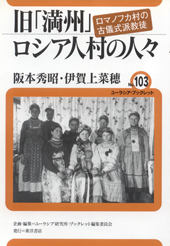
People of the Russian village in former "Manchukuo", front cover The people of Romanovka village were famous for retaining their way of wearing old-style clothes.
Appreciable Japanese interest in Russian agricultural communities was centered on two areas: Romanovka and Trekhrech'e. Romanovka village, now Heilongjiang Province, was located a short distance apart from Hengdaohezi Station close by Mudanjiang City. It was built in 1936 and the population was around 150 people. Trekhrech'e ("Sanga" in Japanese, "Sanhe" in Chinese) Cossack villages in Hulunbuir region, which now belongs to the northern part of Inner Mongolia, had started in the 1920s and grown to become a grain-producing region with more than 20 villages and close to 10,000 residents by the 1940s.
Both the location and the size of these two settlements were very different, however, there was a common feature that the people living in them were not ordinary Russian peasants. The residents of Romanovka belonged to the Old Believers, a branch of the Russian Orthodox Church. The Old Believers were a group that refused to recognize the liturgical reforms implemented by the official Russian Orthodox Church in the 17th century. Romanovka and the other villages of Old Believers in the vicinity were built by those that had fled from the southern part of the Russian Far East (near Vladivostok) facing the Sea of Japan.
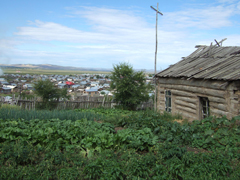
A Russian log house remaining in Shangkuli village, the autonomous region of Inner Mongolia (former Verkhkuli village in Trekhrech'e). (2006)
On the other hand, many of the Cossacks in Trekhrech'e were from the Russian area of Transbaikal (southeast part of Lake Baikal). Cossacks were people with a special military status in the Russian Empire. They were known by their excellent cavalry battle tactics, for example, their presence put a great fear to the Japanese army in the Russo-Japanese War (1904-5). However, in times of peace, most of them engaged in agriculture. In the Russian Civil War (1917-23) after the Russian Revolution, many of the Cossacks joined to a counterrevolution (the White Army) against the Bolsheviks (the Red Army). So, soon after the Soviet regime was established, many of them fled the country. In Manchukuo, a considerable number of Cossacks like Ataman Semenov (a person who had a cooperative relationship with Japan during the Siberian intervention and the Manchukuo period) settled in the urban or suburban areas, while it was the Trekhrech'e region that become famous for the accumulation of Cossacks living there.
Becoming famous villages and the hardships of being governed
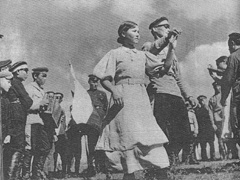
Young Cossacks enjoying dancing (Shashin Shuho (The Weekly Photographic Bulletin) No. 53, Cabinet Information Bureau, 1939)
If we browse Japanese documents written in those days, we can see that these two regions with different characters attracted comparable amount of interest for the Japanese. (Incidentally, Romanovka village was not that well-known within the Russian émigrés community.) The main reason for the popularity of both regions was found in the fact that the people there succeeded to rebuild their livelihoods soon after moving to these areas. In other words they were highly accustomed to being agricultural settlers.
In Romanovka village and the Trekhrech'e region in the time of 1930s to August 1945, a great number of surveys were carried out by the Japanese institutions. The survey organizers were diverse, involving various sections of the South Manchuria Railway Co., Ltd. and a branch of the Institute for Science of Labor (the Institute for Science of Pioneering). Among the surveys, many were conducted for economic reasons, but there were also exceptions, such as a tuberculosis survey (Trekhrech'e region) undertaken by the Medical School of Tokyo Imperial University (now the University of Tokyo). If we open investigation reports of the time, it is surprising to see how thorough the surveys were. They detailed everything including the structure of peasant houses, the methods of raising livestock, the varieties of food and cooking methods, and how they reserved their free time and to what they spent. These two regions were featured again and again in popular magazines and the like, they were also favored subject of novels and paintings. One of the documentary films, Sanga (Trekhrech'e) (1939) shot by the Manchukuo Film Association Ltd., was well preserved and we can watch it today.
Thus, both of these areas became popular to the general public of Japan. In particular, many groups visited Romanovka village which had good access from Harbin and Hsinking (now Changchun), and the village became so popular as if it was a sightseeing spot. The Trekhrech'e region was a border zone with the Soviet Union and visits by ordinary people were restricted. However, Japanese agricultural collectives, the Sanga Cooperative Village and a group of the Pioneer Volunteer Army of Manchuria and Mongolia, made trials of Russian-style lifestyles and agricultural work in this restricted area, practicing the knowledge learned from the Cossacks.
Even in these regions, however, it does not mean that the relation between Japanese and Russian residents was harmonized as in the beautiful slogan of Manchukuo "Ethnic harmony". The youth in both of these areas were conscripted as White Russian units or police officers, and during the Second World War, the residents were obliged to hand over supplies and labor to Manchukuo (that is, Japan). In addition, in the Trekhrech'e region not a few residents were falsely accused of being Soviet spies. When the Soviet army went into the territory of Manchukuo, in August 1945, many adult males in the two areas were arrested on suspicion of collaborating with Japan and sent to the Soviet Union. The remaining people sought to get away from China within the 1950s, and moved to countries including the Soviet Union, Australia, Brazil and United States.
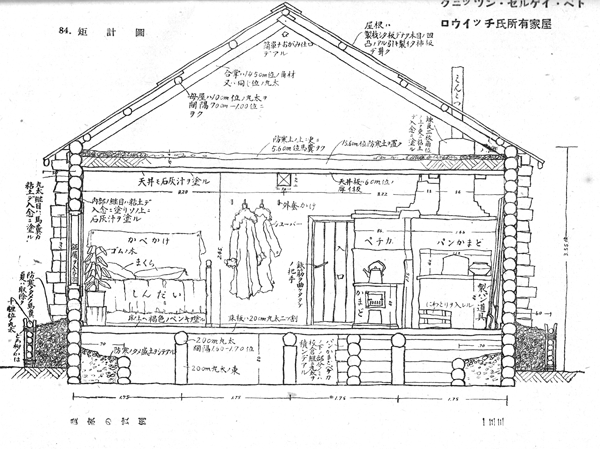
Cross-section view of a Trekhrech'e Cossack house (Housing and Lifestyles of North Manchuria Trekhrech'e Russians, edited by The Research Bureau of the South Manchurian Railway Company (North Manchuria Economic Survey), Hakubunkan, 1943)
Surveys continue in the new era
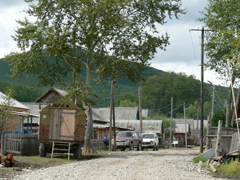
Village of Old Believers of the Khabarovsk region in Russia (2005)
Although many reports on evidence and research about Romanovka and Trekhrech'e Cossack villages have been published over the world, many unanswered questions still remain. I am currently making use of both Japanese and Russian documents to clarify the situations under which the people of both regions were placed, I am also conducting interviews with the former residents and their descendants from those regions. On the Trekhrech'e Cossack communities I am still at the stage of gathering information, but I have already visited Russia and Alaska to meet the former residents of the villages of Old Believers in Manchukuo . Their years of experience since August 1945 taught us the hardships and endurance of the people who passed such turbulent times.
By the way, we can find connections with Japan in the lives of the former residents of Romanovka village and their offspring even today. Since used cars imported from Japan have become very popular in the Russian Far East, in villages of Old Believers it is possible to see many people driving around their favorite Japanese used car. In addition, many of the Old Believers who moved to Alaska are working in fishing industry in the North Pacific and a lot of cod and salmon caught by them are also exported to Japan. The relationship between the Japanese and these people may have changed, but it still continues.
- Naho Igaue
Associate Professor of Cultural Anthropology (Ethnology) and Russian History, Faculty of Policy Studies, Chuo University - Naho Igaue was born in Matsuyama, Ehime Prefecture in 1969. She has a Ph.D. in Language and Culture from Osaka University. In 1992, she graduated from Sophia (Jochi) University after majoring in Russian in the Faculty of Foreign Studies. In 1994, she completed a Master's Program at the Graduate School of Language and Culture in Osaka University. In 2001, she completed her Doctoral Course at the Graduate School of Language and Culture in Osaka University. She has been a lecturer (research fellow) at the Center for Northeast Asian Studies in Tohoku University. She got her current position in 2009 after serving as an assistant professor and part-time lecturer at the Graduate School of Language and Culture in Osaka University. Presently, she studies ethnic relations and the religious situation in Siberia, Russia, various issues related to ethnic Russians resident in former "Manchukuo" and culture and folklore of Russian agricultural communities.
- Her main publications include Northeast Asia (Co-author, Asakura Shoten, 2009), Kyu "Manshu" Roshiajin Mura no Hitobito: Romanofuka-mura no Kogishikiha Kyoto (The People of the Russian Villages of Former "Manchukuo": The Old Believers of Romanovka village) (Co-author, Toyo Shoten, 2007) and Perspectives of Postsocialist Anthropology through Japanese Eyes (Co-author, National Museum of Ethnology Report, 2008).
- Research Activities as a Member of Research Fellowship for Young Scientists (DC1), Japan Society for the Promotion of Science (JSPS) Shuma Tsurumi
- Important Factors for Innovation in Payment Services Nobuhiko Sugiura
- Beyond the Concepts of Fellow Citizens and Foreigners— To Achieve SDGs Goal 10 “Reduce Inequality Within and Among Countries” Rika Lee
- Diary of Struggles in Cambodia Fumie Fukuoka
- How Can We Measure Learning Ability?
—Analysis of a Competency Self-Assessment Questionnaire— Yu Saito / Yoko Neha - The Making of the Movie Kirakira Megane








